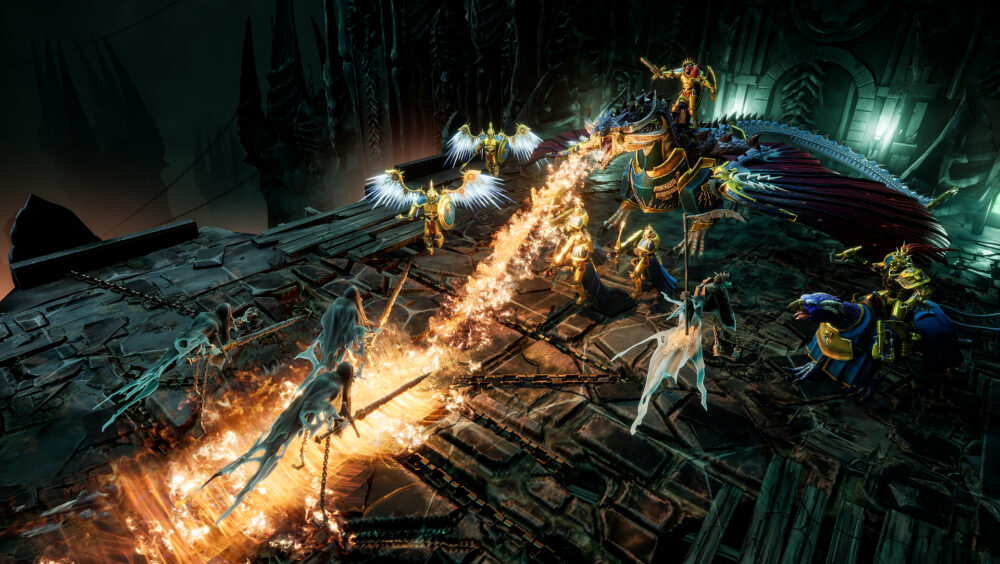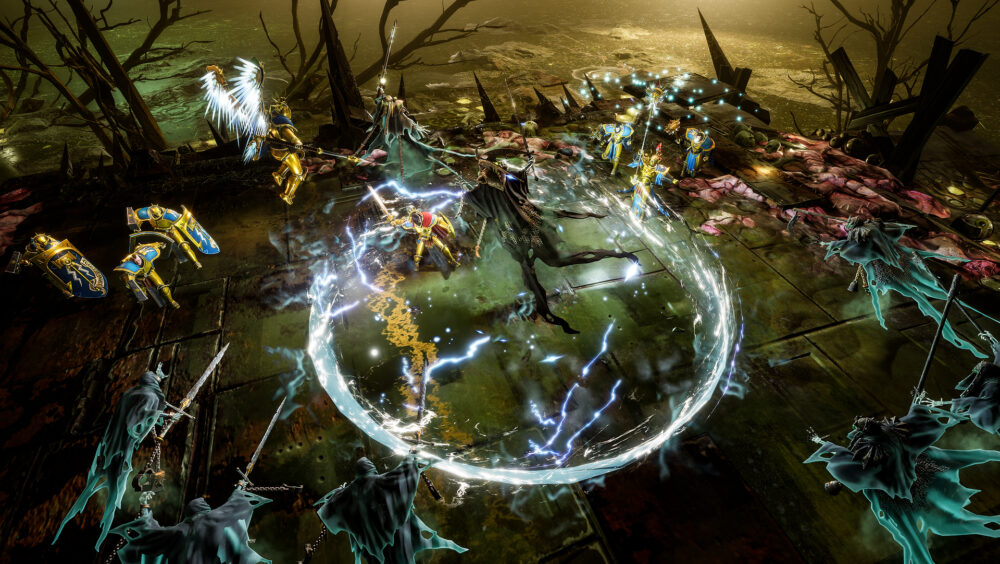You cannot go a day without hearing about yet another Warhammer licensed game in the development of being released with barely any notice. Game Workshop has taken a more is more approach to licensing their incredibly popular tabletop war games to the video game industry. And you can see why the game setting and rules lend themselves to all types of video gaming genres. It is just that Game Workshop’s seemingly haphazard approach is not doing the reputation of the venerable tabletop games a favour.
The latest game to be released is Age of Sigmar Stormground a turn-based rogue-lite that aims to capture the feel of the tabletop game but with a smaller number of units and smaller maps. Stormground takes you away from the standard medieval setting of the tabletop game into the Mortal Realms a world more fantastical than the already fantastical standard setting. Here you will get to fight alongside the other servants of your god as you battle two other gods and their servants to prove who is superior. To be brutally honest I did not really know much about the lore and setting nor did this game make me want to go out and find out more. It is a fine setting for this video game, but nothing spectacular or special enough to draw in the non-fan into a long term obsession the way 40k has.

Playing as one of three factions, The Stormcast in service of the titular Sigmar, the Maggotkin serving the plague god Nurgle or the NIghthaunt, undead servants of Nagash. The name Nurgle tickles m,y memory centres, but for the life of me, I cannot remember where I have heard that name before, possibly one of the demons involved in the X-Men storyline Inferno? Each faction has its strengths and weaknesses such as the Stormcast buffing and supporting each other, while the Maggotkin spread corruption across the map to slow down their enemies while charging more powerful attacks. Very Zerg-like.
This of course leads to replayability as you have three campaigns to play. But also extending gameplay is the rogue-lite structure of the game. Something I did not know about until my first loss halfway through Stormcast’s first campaign. The armies are structured around a hero unit supported by less powerful units of ranged and melee fighters. If you lose any of these lesser units during the battle, they are unavailable for the rest of this run, but if your hero unit dies do not fear, it is sent back to your god and resurrected. Any upgrades or skills you found or were awarded are not lost as are any units you recruited during your failed run, even those that died. This then makes the second, third and fourth runs easier as you gain experience.

The structure is novel for a turn-based strategy game. However, tactically on the battlefield things do not change enough to make you want to put in 100 plus hours as you would with a Hades as the battles become a little rote after a while. In battle, you are confronted with a resource balancing act. You must deploy your hero unit first and that costs you power as does the deploying of your other units. If you decide to hold back your more powerful units, the remaining power is converted to Aether that allows you to use the more powerful attacks and abilities of the units you have deployed. It is an interesting tactical decision you must make, but one I found was not as deep as it could be. I tended towards deploying as powerful a unit as my budget allowed each round and then letting the Aether build for the second and third waves of enemies that you face. Yeah, I forgot to mention that the battles are structured around basically a horde mode tasking you with having to survive waves of attacks.

Enemies are competent attacking your units with some semblance of competence and tactics such as piling on to your weakened units. What I found frustrating was the lack of information on some of the units. In the Stormcast campaign, I was suddenly getting wiped out by exploding Nighthaunt when I killed them. They would just explode and damage any units around them with no warning. I followed the tutorial to bring up the information panels on these units and never figured out what triggered this ability. I would also find myself trying to attack enemies using an ability or just by clicking on them and the units would not respond. Selecting another unit and then the unit you wanted to use seemed to solve it, but it was irritating.
My own carelessness also resulted in me selecting the wrong ability and activating it, to save me from my own stupidity I would have appreciated an “Are You Sure?” dialogue box. Jokes aside you have to take care when deciding which abilities to use as you can easily choose the wrong one so take your time because this is a game that rewards patience.

Stylistically the game maps are suitably dark and foreboding, but the low lighting can sometimes make things a bit difficult to see. Playing on console (Xbox Series X) I found that even on my 55” TV that the text and subtitles were ridiculously small. Most games are now offering you a choice of text sizes in the options menu and this game should’ve implemented something like that.
Overall Age of Sigmar Stormground is a decent if forgettable game. The rogue-lite structure is an interesting twist to your usual turn-based strategy genre, but not enough in the game makes this a standout amongst the plethora of such games as well as the number of Warhammer games out there. For fans of Warhammer, Age of Sigmar or anyone looking to scratch that tactical itch this is a good stop-gap until the next Total War: Warhammer or Xcom, but for casual fans of the genre or people interested in trying this out, I would suggest looking at something else.
Developer: Gasket Games
Publisher: Focus Home Interactive
Platforms: PlayStation 4, Nintendo Switch, Microsoft Windows, Xbox One
This review is based on the Xbox version of the game which can be purchased here for £32.99.
Enjoy the review? want to read more of our reviews? then click right here to be whisked away to the realm of our opinions.








You must be logged in to post a comment.